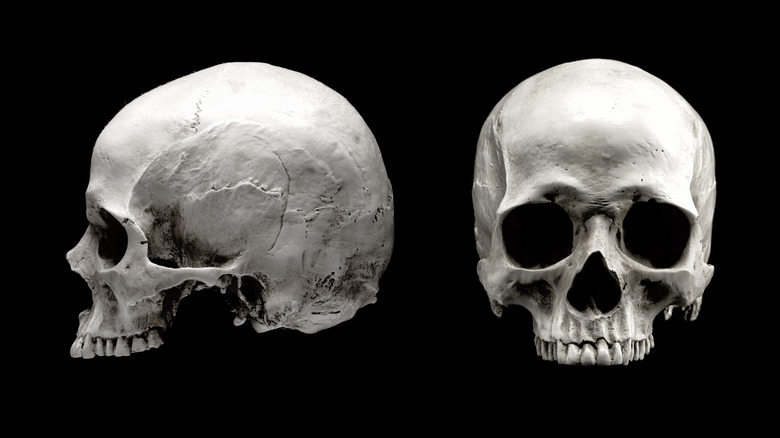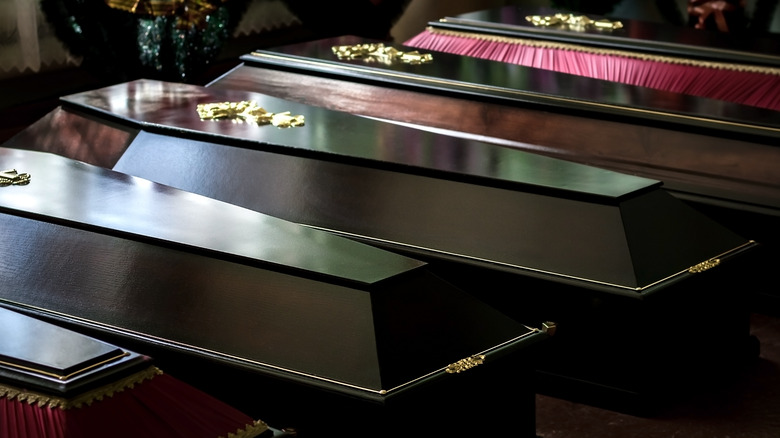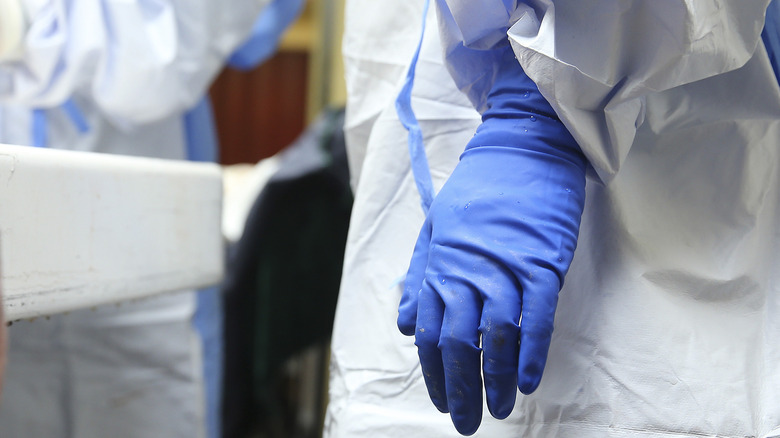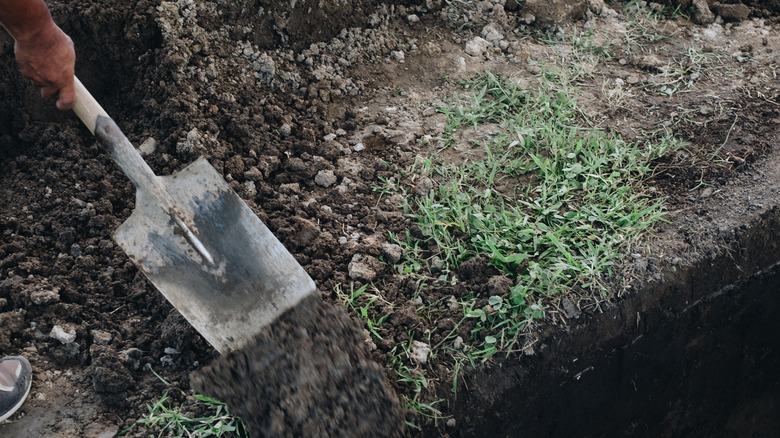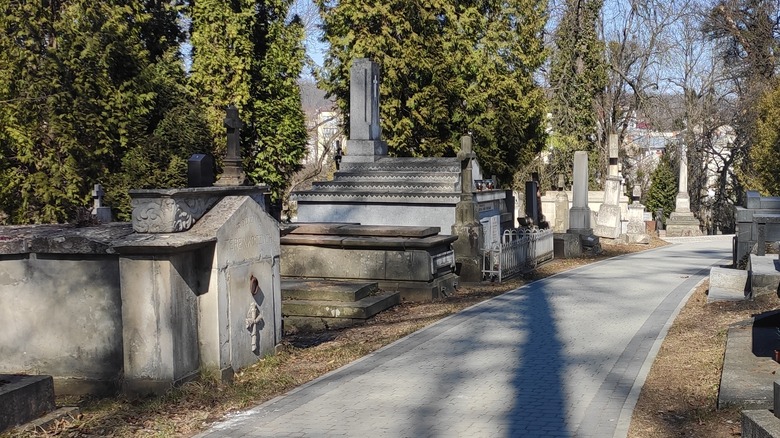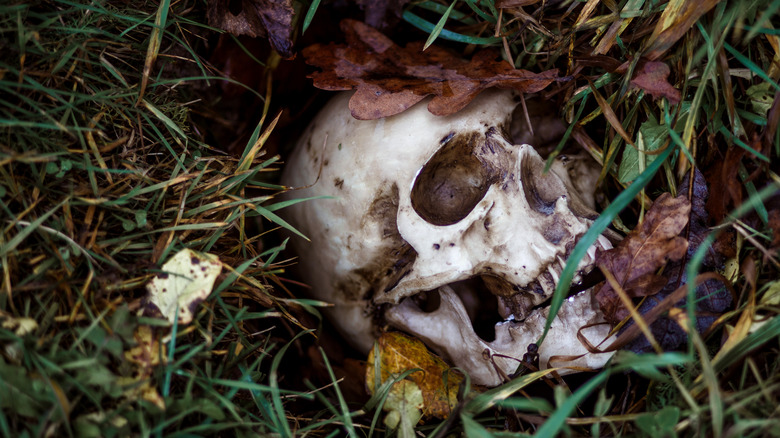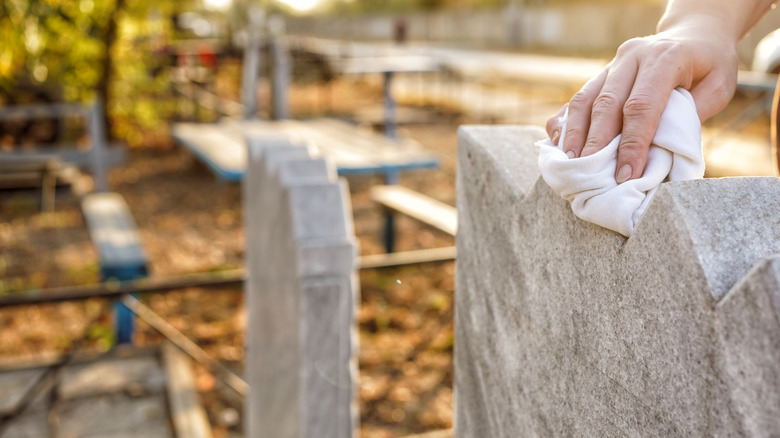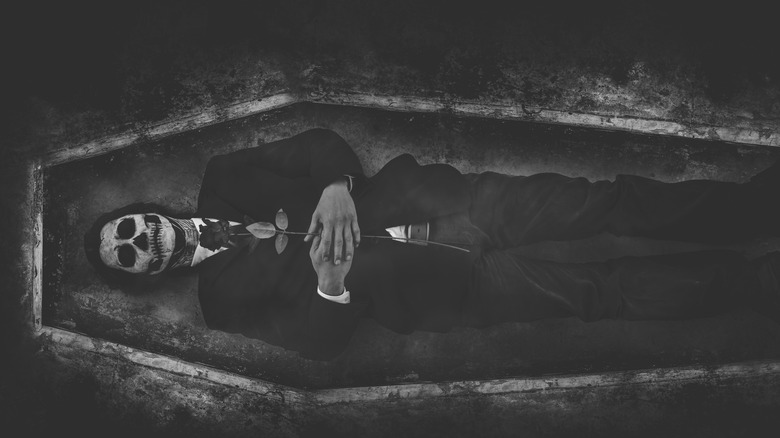What Happens To Your Body After One Year In A Coffin
The following article includes detailed descriptions of human decomposition. Reference links may include science and medical photographs that some readers may find disturbing.
Humans often cope with death by disguising it as life. Corpses rest in peace and take dirt naps. Many people believe in an afterlife — from heaven to Valhalla — a concept that not only denies the finality of death but literally describes it as a different form of life. Perhaps the most glaring example is the open-casket funeral, when humans go through the effort of dressing up a dead person in nice attire and laying them in a giant jewelry box with plush lining, almost creating the impression that they're sleeping in a claustrophobic bed. As time passes, that eternally sleeping beauty will undergo some drastic changes on its journey from fresh corpse to skeleton. Here's how your body might change over a year of eternal beauty sleep.
The type of casket or coffin matters
Unless a body is exhumed, it's unlikely that anyone will see the corpse again after it is put in the ground. However, under the soil, the body is changing, and how fast the body decays changes depending on what container it's placed in.
As detailed by Norman Cantor in "After We Die: The Life and Times of the Human Cadaver," burying a body in a coffin or casket of any kind slows decomposition. Wooden coffins were the norm prior to the 1860s and have become increasingly popular again in recent years with the rise of "green burial" or eco-friendly burial options. As one might expect, these coffins rot and collapse underground, allowing the body to decompose more naturally with the assistance of soil and insects. Elsewhere, the American funeral industry often recommends expensive hermetically sealed metal caskets, sometimes with a rubber seal and a cement vault around the coffin. Theoretically, these will slow decay, but the body inside the casket will still rot. As noted in a report from The Washington Post, the buildup of gasses inside sealed coffins can even cause the corpse to explode.
Some estimates state that an unembalmed corpse in a sealed metal coffin may take as many as 40 years to become a skeleton, but that does not mean that it would look the same as it did at the funeral if it was exhumed at the end of its first year — it simply decomposes differently than a body in a wooden coffin.
How a body is treated for burial matters
Although it isn't legally mandatory in the United States, many choose to have their loved ones embalmed before burial. As stated by Time, this process, which introduces gallons of preservative into the corpse, is more common in the United States than anywhere else in the world. Not every family chooses embalming: Jewish and Muslim families traditionally do not have the bodies of loved ones embalmed, and the increasingly common "green burials" have discouraged embalming due to the risks of leaching toxic embalming fluid into the earth. Whether or not a body is embalmed impacts how quickly decay begins — but nothing can truly stop decomposition.
As stated in "After We Die," under normal circumstances, a human corpse changes significantly within just a few days of death. To avoid friends and family members of the deceased being forced to confront mortality, funeral homes frequently use a liquid preservative along with multiple cosmetic techniques to keep the corpse looking more lifelike until burial. Typical embalming practices are designed to prevent extensive decay for several days or weeks. After that, decomposition continues.
Where a body is buried matters
All bodies will eventually decompose, but what the burial place is like can change the timeline drastically. Some situations would cause a body to break down in only a week or two, while others can preserve corpses for years. The mere act of burying a corpse slows how quickly it decomposes. As explained by mortician Caitlin Doughty, in general, bodies buried the standard 6 feet underground break twice or even four times slower than they would if left exposed. Other sources, like "Evaluation of Postmortem Changes," estimate that it may be as much as eight times slower. Even in a coffin, the environment around a body also changes how quickly a body decomposes and what it looks like after one year.
In hot, humid conditions, research has shown that a body might decompose in just a week or two, whereas a cold environment can preserve a body for years. Scavengers, particularly insects, speed up decomposition. As stated in "Evaluation of Postmortem Changes," flooding of a gravesite can cause the corpse to decompose completely differently. If scavengers are able to access a body, it can break down almost completely in as little as a month and a half.
The first 48 hours
When allowed to decompose naturally, a body goes through many changes during the first two days. As described in The Guardian, decomposition begins within a few minutes of death.
As explained by Dr. Stephanie R. Dillon's "Death and Kinetics," blood in the body is no longer pumping and instead pools wherever gravity takes it. Every hour, the body cools by approximately 1.5 degrees F. As the processes of life stop, cells begin to break down and leak enzymes into the body. The first of these are typically the liver and the brain. In approximately 3-8 hours, the body becomes stiff as acid builds up in the muscles. Typically, this stiffness goes away after around 36 hours, but different temperatures change how quickly rigor mortis sets in, meaning the process could take up to a full day longer under the right conditions.
Embalming attempts to conceal these first signs of death cosmetically and delay more serious decay from the beginning until the body is in the ground. As stated in "After We Die," the first time a body is placed into the coffin or casket, funeral directors attempt to make the body look as lifelike as possible. Often the embalming fluid replacing the deceased's blood is tinted to bring a warmer tone to the skin. They may also use mortuary putty, plastic forms, and lenses under the eyelids to conceal any areas where the body has sagged.
1 to 4 weeks
It can be difficult to accurately gauge how long it takes for a corpse to reach different states of decay because some parts of the body decompose more quickly than others, meaning that at any given time, a single body may be in multiple stages. After four days, parts of the body will likely have moved from fresh into the stage known as "bloated."
As stated in "Evaluation of Postmortem Changes," before anything else changes, the skin starts to turn a greenish color. As implied by the name of this state of decay, parts of the body begin to swell. As detailed in "After We Die," the body at this point will have a strong smell of decay. Liquid may come out of the body, and the skin may blister. Insects like coffin flies are attracted to the body at this stage if they are able to travel through the soil and into the coffin — something that the Natural History Museum points out that they are remarkably adept at doing. They are able to burrow down more than 6 feet into the earth.
An exposed, unembalmed body might remain in this phase for only a week or two, but decay can be slowed by burial, temperature, and other factors, so it is likely that a body buried 6 feet deep in a casket would remain partially in this state for far longer.
6 to 8 weeks
Studies (like this one from the Australian Museum) have found that when left exposed in hot climates, the next stage of decomposition can begin within the first week, but buried corpses decompose eight times more slowly, as explained by "Postmortem Changes." It may take several months or even years for parts of a body to reach what "Evaluation of Postmortem Changes" refers to as "black putrefaction," or advanced decay.
During this highly variable phase, the previously swollen corpse collapses and caves in on itself. The skin may blacken, and some bones may be visible. As detailed in "Forensic Anthropology and Medicine: Complementary Sciences From Recovery to Cause of Death," it is entirely possible for a single body to have parts in two or even three different states of decay. Depending on the coffin or casket that the body is buried in, whether it has been embalmed or not, and the temperature, a corpse may decay in several different ways, including butyric fermentation, forming corpse wax, or mummifying.
3 to 6 months
After a few months have passed since death, there are a few ways that a corpse can decay. One of the most interesting is known as "corpse wax." After around three months, this strange substance can begin to form if the conditions are right. As explained in "Postmortem Changes," in warm, humid environments, the body can go through a process known as "saponification" or "adipocere formation." The corpse's fatty tissues, particularly around the cheeks and abdomen, turn into a yellow waxy substance. Over time, the wax turns white and becomes hard. Fascinatingly, this form of decay actually preserves the body.
Like other states of decay, it is entirely possible for some parts of the body to develop corpse wax while others do not. In some cases, it forms a kind of sealed shell around the corpse. While this process may be bizarre, it isn't necessarily rare for buried bodies. As noted by Gizmodo, this is the norm in some German graveyards, where bodies more than three decades old have been extremely well-preserved in their own wax.
6 to 9 months
As the corpse decays over time, fresh disintegrates and rots, leaving more of the bones exposed. When approximately half of the skeleton is visible, the body enters what is known as the "skeletonization phase."
As stated in "Forensic Anthropology and Medicine," whether the body mummified or was covered in corpse wax at some point in its decomposition process, it will eventually skeletonize. When more than 50% of the body has been reduced to bones, the rest of the body may be in one or more other states of decay. As explained in "Methods of Estimation of Time Since Death," in situations that speed up decomposition — like a body exposed to the elements in high temperatures — the skeleton might start to be seen after as little as two months, but it can take as long as nine months for half of the skeleton to be visible. It can take years for the remaining bones to be revealed.
1 year and beyond
Every body will decay, but no two bodies will decay in the exact same way. How exactly a corpse will look a full year after burial can vary extremely. As detailed in "After We Die," the transformation from cadaver to bones can take a long time. It is estimated that a body that was not embalmed and was buried in a pinewood coffin could have nothing left but bones between 5 and 12 years after, with all the fluid having leaked into the soil and the flesh having fully rotted away. Meanwhile, an embalmed body in a metal casket may take 40 years to become a skeleton. Those who have exhumed bodies like these have reported skeletons completely coated with wet black mold.
After 365 days in the coffin, different bodies will have decomposed differently. A body that was embalmed and buried in a steel casket in a cool, dry climate may still be in an early stage of decay, while one in a pinewood box in a hot climate may have already begun to skeletonize. Elsewhere, a body in a frequently flooded cemetery may have become preserved and coated in corpse wax. While some bodies take decades to decompose and others transform in a matter of days, all bodies eventually decay.
Your corpse might go out with a bang
No matter how peaceful your death is, you'll never rest in one piece, thanks to the magic of decomposition. But under certain circumstances — particularly if your coffin is kept above ground in a mausoleum — the rest of your pieces could be flung everywhere as your coffin explodes in a blaze of, well, not glory, but gory. Josh Slocum, executive director of Funeral Consumers Alliance, explained to Vice that "the casket becomes a literal pressure cooker. It reduces the body to a disgusting chunky brown slurry." And when that pressure reaches the coffin's tipping point, then you have corpse goo spilling out over the place. Slocum noted that in some cases, the pressure has been powerful enough "to blow that little square front off the front of the crypt."
Slocum likened it to leaving a Tupperware container full of meat in your fridge for too long. And since your corpse produces refrigerator coolant, that comparison is even more apt than it sounds on the surface. After all, at the end of the day and the end of your life, you're sentient meat waiting for your biological clock to stop ticking, at which point mealtime begins for microbes that eat you.
